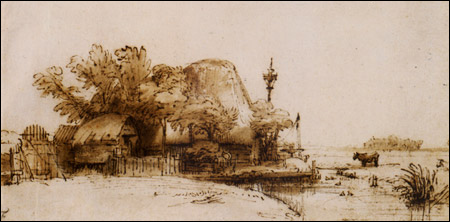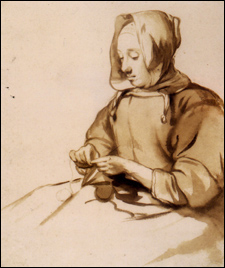Rare watercolors bloom among master drawings:
‘Bruegel to Rembrandt: Dutch and Flemish drawings from the Maida and George Abrams Collection’ opens at the Fogg Art Museum

An exhibition of more than 100 drawings from the Maida and George Abrams Collection will open at Harvard’s Fogg Art Museum on March 22, and will remain on view through July 6. The collection includes Dutch and Flemish drawings and is the foremost group of 17th century Dutch drawings in private hands. The exhibition will highlight recently acquired works and will allow visitors to examine many important drawings that have seldom been on public display.
“Bruegel to Rembrandt” will feature the Abrams’ most significant acquisitions in the past decade, including works by Rembrandt van Rijn, Pieter Bruegel the Elder, Hendrick Avercamp, Jan van Goyen, Joachim Wtewael, and Cornelis van Haarlem. The exhibition will also showcase a rare group of watercolors depicting plants and animals.

Two-thirds of the exhibit will consist of important works not included in the 1991-92 exhibition “17th-Century Dutch Drawings: A Selection from the Maida and George Abrams Collection,” also organized by the Harvard University Art Museums (HUAM).
“Maida and George Abrams have been strong supporters of the Harvard University Art Museums’ tradition of connoisseurship as the foundation for learning about and enjoying works of art,” said Marjorie Cohn, acting director of HUAM. “Through their sustained commitment to the arts community, their ongoing gifts of works of art, and their role in developing exhibitions, Maida and George have encouraged generations of students to explore firsthand the rich field of Dutch drawings.”
Landscape Drawings
The first section of the exhibition will consist of works by landscapists from Pieter Bruegel the Elder and his Flemish followers to the pioneers of the genre in the northern Netherlands. Among the most significant works in this group is “Wooded Landscape with a Distant View toward the Sea” (1554) by Pieter Bruegel the Elder. This work was unrecorded prior to a 1991 sale, where it passed as a signed drawing by Jan Brueghel the Elder, son of Pieter Bruegel the Elder; it was then acquired by the Abrams in 1992 as the work of an unidentified 16th-century Flemish artist. It remained anonymous until early 1994, when scholar Hans Mielke, working from a photograph from the original, recognized the hand of Pieter Bruegel the Elder and affirmed the inscription of the artist’s name as his authentic signature.
Among other landscape drawings to be included in the exhibition are two works by Cornelis Vroom – “River Landscape” (c. 1622-23) and “Landscape with a Road and a Fence” (1631). The former is one of the artist’s earliest-known drawings. Only 25 of his drawings have survived, and just three of them are privately owned.
Figural Drawings
A strong selection of figural works created from the 1590s through the 1620s will follow the landscape drawings. This second group includes biblical subjects, portraits, studies of models, and scenes of daily life by Hendrick Goltzius, Jacques de Gheyn II, Abraham Bloemaert, Roelandt Savery, Willem Buytewech, and others.
This section will include “The Truce” (1612), a technically flawless and impeccably preserved drawing by Joachim Wtewael that belongs to his renowned suite of drawings known as “The Netherlandish History.” The only dated work in the suite, “The Truce” has never been exhibited publicly.
Rembrandt and Pupils
Drawings by Rembrandt and his pupils and followers will form the third section of the exhibition. Among the most significant works in this group are “A Farm on the Amsteldijk” (c. 1650-52), which was one of the 27 Rembrandt landscape drawings acquired in 1723 by the 2nd Duke of Devonshire and preserved at Chatsworth until the 1980s. The seamless provenance and exceptional quality of these drawings make them the most important extant group of Rembrandt landscapes.
Landscapists and Marine Artists, and Figure and Genre Drawings
The next major group will feature landscapists and marine artists from the 1640s through 1700. One fine example is Roghman’s “Develstein Castle” (1647), part of the artist’s series documenting Dutch country houses. These topographically accurate records of historic Dutch houses, many of which no longer exist, are of important documentary value.
This section will present a significant group of figure and genre drawings from the same period, including works of peasant subjects by Haarlem artists Adriaen and Isack van Ostade, Cornelis Bega, and Cornelis Dusart.
Watercolors: Art & Science
Watercolors by masters who specialized in natural history illustration – including exceptional examples by Johannes Bronkhorst, Maria Sibylla Merian, and her stepfather, Jacob Marrel – will also be among the special sections of the exhibition.
This section of the exhibition also includes “Flowers” (c. 1705) by Maria Sibylla Merian, a naturalist, artist, teacher, publisher, and merchant dealing in paints and preserved specimens. This work is a rare surviving example by Merian of a sheet of studies that could be incorporated into formally composed watercolors.




